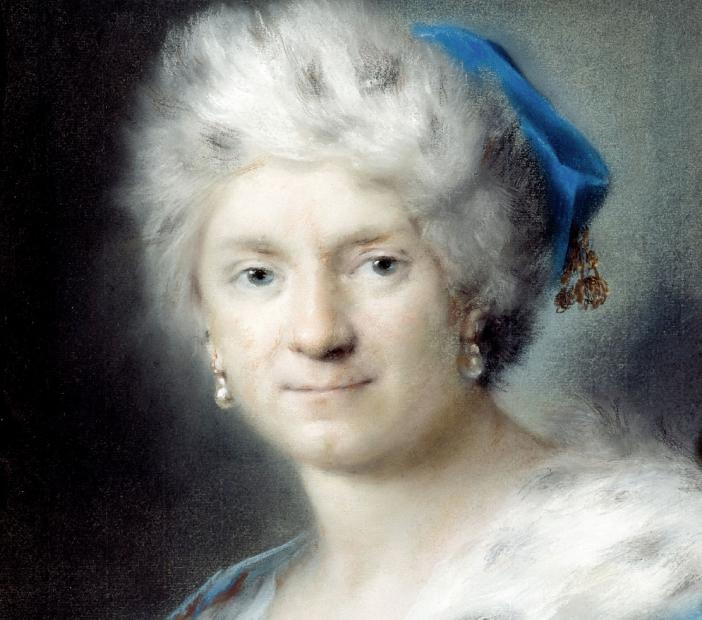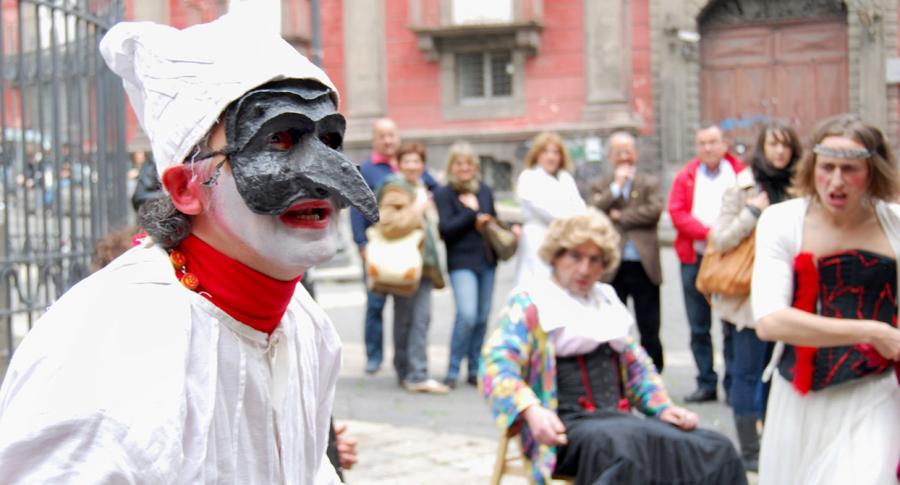One cannot say that Rosalba Carriera was the best woman painter in Europe, since in the opinion of most art critics that merit belongs to Artemisia Gentileschi. But one can affirm without a doubt that Rosalba Carriera had the most successful career of any woman artist who ever lived in Europe. At the Uffizi Gallery in Florence, among the works of art collected by Duke Cosimo III de’ Medici, I find Rosalba Carriera’s self-portrait. In the painting, Rosalba is staring right at me, showing with her left hand an unfinished portrait of her sister. Rosalba appears serene in her maturity, her hair is powdered, according to the fashion of the times, and her expression is modest, yet confident. This image is an advertisement for her art, as well as a reflection of her closeness to her family.
The Veneto region has always been an especially fertile ground for women artists, whether writers or painters. Rosalba was born in Venice on October 7, 1675, and after peregrinations throughout Europe, she died in Venice on April 15, 1757. She had a long and busy life, and was regarded not only as a great painter, but also as a woman of genius. At a very early age she had to work for a living, and became well known as a painter of miniatures; later she moved on to larger paintings, for the most part portraits.
Noblemen and international celebrities, who had travelled to Italy for the Grand Tour “de rigueur” in those days, frequented Carriera’s fashionable studio on the Grand Canal. Venice was at that time a major center of import-export trade, so Rosalba had the opportunity to make herself known all over Europe. Rosalba is remarkable for being the first woman painter to be admitted to art academies, a major feat since in those days academies did not admit members of the female sex: in 1705 she was admitted to the Accademia di San Luca in Rome, and later also to the Academy of Arts in Paris.
In 1716 Rosalba made friends with Pierre Croizat, the famous French critic and art connoisseur, and a few years later accepted his invitation to go to Paris. Modest and unmarried as she was, Rosalba was also daring and adventurous. But she left for France with her mother, sisters, and a brother-in-law in tow. She liked the security of her family. She was well received in Paris, and immediately met the major French painters of her time, including the famous Watteau. In fact, Rosalba painted what is regarded as the best portrait of Watteau: we have it now at the Museo Civico of Treviso. Rosalba, Watteau and their immediate circle were in great part responsible for the development of the style that became known as “rococo.” A style famous for delightful representations of humans and of nature that shunned all that was ugly or unpleasant.
Rosalba was very hard working, and was immediately inundated with commissions from all over Europe, especially requests of portraits, for which she became famous. Dukes, counts, celebrities and noblemen of many European countries counted it an honor to be painted by her. She also influenced famous painters such as the French Quentin de la Tour and later the Venetian Marianna Carlevaris.
In an age when painters used oil paint, Rosalba chose to paint using pastel, an ephemeral medium compared to oil. Even now we use the term “pastel” to indicate delicate, pleasing, luminous colors. The Italian word “pastello” means made of paste, since in order to form the stick used by the painter the pigments had to be pounded in a mortar, softened and thus made easy to use. Rosalba used pastel on dark blue paper, a most personal technique that gave her work definition as well as luminescence, as the colors overcame the darker paper they were laid on. Her work is always pleasing, and reflects the taste and the exquisite elegance of her times. But she was also famous for her uncanny capacity to grasp and portray the personality of her subjects: her paintings are definitely psychological studies in their own right. One does not find anything too harsh, or too dark in Rosalba’s paintings. And yet, she lived during the time when the violent forces that ultimately led to the French Revolution were seething. She died before she could see their dire effects.
In 1721 Rosalba returned to Italy to execute some paintings at the court of Modena; then in 1730 she moved to the Hapsburg court in Vienna. She reaped honor after honor, wealth and recognition. Yet, her old age was marred by the cruelest fate that could befall a painter: the loss of her eyesight. She spent the last days of her life blind. It has been reported that without sight and light, without being able to paint, she went mad.
Owing to her international travels and her invitations to the most famous courts of Europe, Rosalba’s work is scattered all over Europe. Many of her paintings can be found in her native Venice, at the Galleria dell’Accademia and at Ca’ Rezzonico, others are at the Uffizi in Florence, many of them are in Dresden, Germany, in Russian museums, and at the Louvre in Paris. One of her portraits is at Buckingham Palace. Many more paintings are hidden in private collections. Her portraits are of children, men and women; but the most famous ones are of women, aristocratic, rich women who paid fortunes to be immortalized by her brush. Many women chose to be represented as mythological figures or as representations of the seasons. In some of these later paintings, Rosalba portrays the sitter in risqué, titillating poses, often showing her breasts. Take a look for instance, at the painting of Flora (1730), a part of the “Allegory of the Seasons.” We know Rosalba was never married, and that she lived always surrounded by her family. She was, one could say, the Jane Austen of painting. Many have wondered whether she was ever touched by the intensity of love, by the lure of sexual attraction. Or did she truly stay away from any fierce emotion that might upset her art or her life? Looking at the some of her overtly sexual paintings, one wonders.
We are fortunate to have several paintings by Rosalba in the United States, so that we can go and admire them in person. One is the famous personification of “America” at the National Museum of Women in the Arts in Boston, representing a beautiful native American woman armed with bow and arrow; also in Boston, at the Museum of Fine Arts, we find a portrait of the handsome French King Louis XV, as well as a “Portrait of a Woman with Jewels.” In Washington D.C, at the National Gallery of Art, we have an alluring “Allegory of Painting.” In Cleveland we find a fascinating “Head of a Woman.” We are fortunate to have two Carriera paintings in California: a “ Head of Diana,” at the Museum of the Legion of Honor in San Francisco, while in Los Angeles, at the J.P. Getty Museum, we find the most enticing “Muse Crowned with a Laurel Wreath.”
Rosalba Carriera reflected the ideal of grace, elegance and beauty of the last decades of the eighteenth century, the age of Enlightenment. But her world was already doomed: just a few years after her death, with the French Revolution and the advent of Napoleon, that world was shattered for ever. But it will always live in her paintings.
Recenty, an interesting novel was published by Valentina Cesarotto: “Il segreto nello sguardo. Memorie di Rosalba Carriera prima pittrice d’Europa.” (The secret in the Glance, Memoires of Rosalba Carriera foremost woman painter of Europe).
The author writes in the persona of Rosalba Carriera, beginning the narrative in Venice in April 1741. Old and almost blind, no longer able to paint, Rosalba decides to write her story. The narration is crowded with the most important and famous people of her times. Though not a biography but a work of imagination, this book provides an insight in the formation and the soul of this most exceptional woman.































